Four ‘Pur’ Micro-Terroir ‘Climat’ Scores with a Maestro in Three Beaujolais Village Crus: Terroir. Terroir. Terroir. (8-Bottle Pack $314, Tax Included)
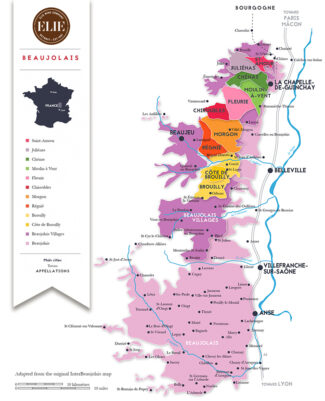 As a wine term, ‘terroir’ transcends nationality. It leapfrogs appellations and vaults borders; it is a small package within a warehouse of nuances. Literally, it may mean ‘dirt’, but only in the context under which soil exists as part of a larger system. Terroir encompasses climate, topography, biodiversity, and in some cases, cultural heritage. Defined more accurately than ‘soil’, terroir can be translated as a ‘sense of place.’ According to the theory of terroir, the essence of a wine from a specific location should be identifiable based on this location.
As a wine term, ‘terroir’ transcends nationality. It leapfrogs appellations and vaults borders; it is a small package within a warehouse of nuances. Literally, it may mean ‘dirt’, but only in the context under which soil exists as part of a larger system. Terroir encompasses climate, topography, biodiversity, and in some cases, cultural heritage. Defined more accurately than ‘soil’, terroir can be translated as a ‘sense of place.’ According to the theory of terroir, the essence of a wine from a specific location should be identifiable based on this location.
With one of the richest and most complex geologies in France, Beaujolais has further refined the mechanics of terroir into a celebration of their micro-terroirs, variously known as ‘lieux-dits’ or ‘climats’. At the request of the Inter-Beaujolais Council, a nine-year analysis was done by a soil mapping agency to assist winegrowers and négociants in highlighting the region’s ability to express itself in plot-by-plot cuvées. Although physically small, Beaujolais contains over three hundred individual soil types representing over 500 million years of geological history, and unlike Bordeaux, the Loire or the Rhône, there is but a single grape variety used in the production of all its red wines: Gamay. Whether Cru, Beaujolais-Villages or simply Beaujolais, Gamay has a chameleon’s ability to draw inspiration from the earth and change its face to suit the mood, displaying the sensuous simplicity of an easy-drinking summer wine or the brooding complexities of a cellared gem.
Daniel Bouland
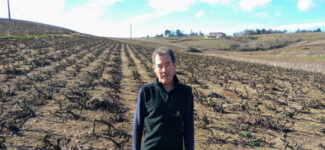
Daniel Bouland in Morgon’s lieu-dit ‘Les Delys’ with Gamay vines planted in 1926.
Daniel Bouland has been called reclusive and solitary—he has also been called the best artisanal vigneron in Beaujolais. When collectors compare him to more flamboyant regional names like Foillard and Lapierre, it is always favorably, at least in part because of his obsessive respect for micro-terroirs—in French, ‘pur’ terroir. Working with fewer than twenty acres of impeccably cultivated vines in the Morgon lieux-dits of Corcelette, Bellevue and Delys, plus small parcels in Chiroubles and Côte de Brouilly, Bouland’s wines are approachable upon release, but created with such a backbone that his terroir’s mineral nuances will continue to become more pronounced with five or more years in the cellar. These long-haul wines frequently come from very old vines (some approaching a hundred years of age) whose naturally low yields Bouland hand-harvests and ferments on native yeasts. Equally interesting are his younger vines, which are propagated using an old-school technique known as ‘Selection Massale’ wherein new plants are grown with cuttings from exceptional old vines from the same lieu-dit. More difficult than the clonal selection vines which have been dominant since the 1960’s, Selection Massale tends to produce vines that are less uniform and better able to express terroir, a feat at which Daniel Bouland is a master.
Chiroubles
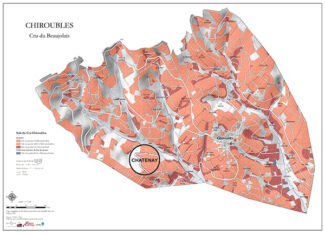 With a mere eight hundred acres under vine, Chiroubles is slightly west of center among the northern crus of Beaujolais. The soil structure here—sandy, eroded granite—is similar to Morgon, but the vineyards sit at higher elevations, where there is a more pronounced diurnal temperature shift than in the rest of Beaujolais. The wines tend to be lighter and fresher and are often considered emblematic of Beaujolais’ image as a whole.
With a mere eight hundred acres under vine, Chiroubles is slightly west of center among the northern crus of Beaujolais. The soil structure here—sandy, eroded granite—is similar to Morgon, but the vineyards sit at higher elevations, where there is a more pronounced diurnal temperature shift than in the rest of Beaujolais. The wines tend to be lighter and fresher and are often considered emblematic of Beaujolais’ image as a whole.
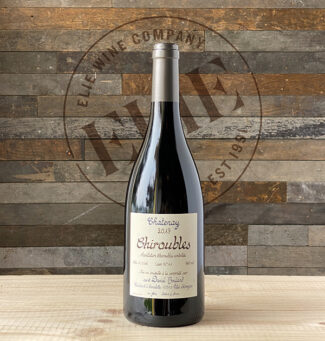 2019 Daniel Bouland ‘Chatenay – Cuve No 11’ Chiroubles ($36): The lieu-dit of Chatenay sits high upon the hill of Chiroubles where soils are sandy and friable, producing an archetypal regional wine; aromas of violets and herbs form top-notes while below them, cherry and subtler spice are front and center. Tannins remain in the background and lead to an appealingly long finish.
2019 Daniel Bouland ‘Chatenay – Cuve No 11’ Chiroubles ($36): The lieu-dit of Chatenay sits high upon the hill of Chiroubles where soils are sandy and friable, producing an archetypal regional wine; aromas of violets and herbs form top-notes while below them, cherry and subtler spice are front and center. Tannins remain in the background and lead to an appealingly long finish.
Côte de Brouilly
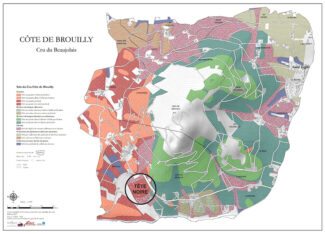 Nestled along slopes of a dormant volcano, Côte de Brouilly is one of the ten Beaujolais Cru appellations. It’s also among the smallest and most southerly. The proximity of the volcano has left the soil saturated with rare blue diorite, a phenomenon that leaves the soil thin and stony—an ideal underbelly for deeply rooted, low yielding vines with an excellent concentration of flavor. The best vineyards of Brouilly are planted on the south-east-facing slopes of Mont Brouilly. These vineyards are protected from winds from the nearby Beaujolais hills by Mont Brouilly itself, and are instead subject to early morning sunlight.
Nestled along slopes of a dormant volcano, Côte de Brouilly is one of the ten Beaujolais Cru appellations. It’s also among the smallest and most southerly. The proximity of the volcano has left the soil saturated with rare blue diorite, a phenomenon that leaves the soil thin and stony—an ideal underbelly for deeply rooted, low yielding vines with an excellent concentration of flavor. The best vineyards of Brouilly are planted on the south-east-facing slopes of Mont Brouilly. These vineyards are protected from winds from the nearby Beaujolais hills by Mont Brouilly itself, and are instead subject to early morning sunlight.
 2019 Daniel Bouland ‘Cuvée Mélanie Cuve No 1’ Côte de Brouilly ($36) originates in the volcanic blue schist lieu-dit called ‘Tête Noire’. Named for Daniel Bouland’s daughter, the wine is grape-jelly purple with well-marked and velvety tannins and a pronounced, soil-driven minerality. Very floral on the nose and fresh, juicy and fruity on the tongue, it shows a well-ripened cherry, bright blackberry and damson character.
2019 Daniel Bouland ‘Cuvée Mélanie Cuve No 1’ Côte de Brouilly ($36) originates in the volcanic blue schist lieu-dit called ‘Tête Noire’. Named for Daniel Bouland’s daughter, the wine is grape-jelly purple with well-marked and velvety tannins and a pronounced, soil-driven minerality. Very floral on the nose and fresh, juicy and fruity on the tongue, it shows a well-ripened cherry, bright blackberry and damson character.
Morgon by Morgon
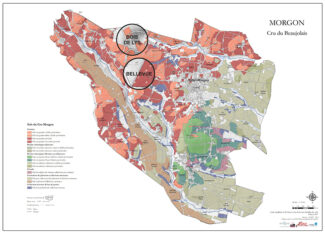 Morgon covers fewer than five square miles, yet contains six distinct and identified ‘climats’, making it, perhaps, the wine world’s poster child for micro-terroir. Morgon wines tend to be dark and chewy with a marked ability to age—so distinctly, in fact, that a French expression ‘il morgonne’ is used to describe a wine that is well-served with cellar time. The soils of Morgon may range in texture from sandy loams to heavy clay, but all are rich in iron that lend earthy depths to the wines rarely found in the other Beaujolais Crus.
Morgon covers fewer than five square miles, yet contains six distinct and identified ‘climats’, making it, perhaps, the wine world’s poster child for micro-terroir. Morgon wines tend to be dark and chewy with a marked ability to age—so distinctly, in fact, that a French expression ‘il morgonne’ is used to describe a wine that is well-served with cellar time. The soils of Morgon may range in texture from sandy loams to heavy clay, but all are rich in iron that lend earthy depths to the wines rarely found in the other Beaujolais Crus.
First and foremost, Daniel Bouland is a Morgon vigneron who understands the shine and shadow of Morgon’s terroirs as well as any producer alive; his cuvées are brawny and bold, but never overpowering thanks to a winemaker’s gift for restraint where required and an innate ability to highlight Beaujolais’ most cherished trait: Approachability. The contrast between two climats within Morgon’s ‘Bellevue’ and ‘Les Delys’ vineyards demonstrate Bouland’s deft hand at coaxing individual and identifiable greatness from the dirt beneath his feet.
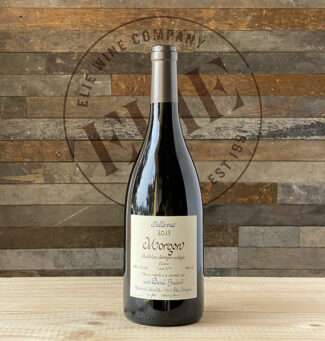 2019 Daniel Bouland ‘Bellevue – Cailloux Cuve No 3’ Morgon ($37) is layered, succulent and concentrated with revealing aromas of raspberries, cherries and wild plums underscored by a bit of flint-smoke and sweet, earthy richness. The deep fruit core easily rides the powdery tannins, uplifted by bright acids.
2019 Daniel Bouland ‘Bellevue – Cailloux Cuve No 3’ Morgon ($37) is layered, succulent and concentrated with revealing aromas of raspberries, cherries and wild plums underscored by a bit of flint-smoke and sweet, earthy richness. The deep fruit core easily rides the powdery tannins, uplifted by bright acids.
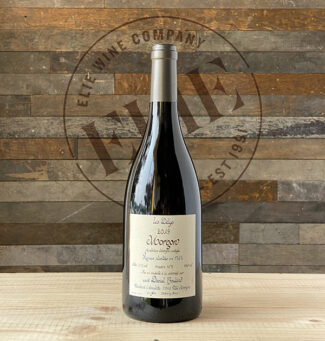 2019 Daniel Bouland ‘Les Delys – Foudre No 8’ Morgon ($39): On the label, it announces in bold blue: ‘Vignes plantées en 1926.’ And in fact, these vines—gnarled, globe-shaped works of tortured art (see picture)—are nearly a century old. From them emerges a wine displaying a labyrinthine of sweet and savory layers; baking chocolate, grilled meat and a bouquet of wild herbs wrapped around a succulent cornucopia of ripe plum, blueberry, orange peel and cranberry. Foudre No 8 is among Bouland’s most age-worthy wines; Beaujolais’ 2019 growing season provided fierce heat throughout the summer and cool rains in the early fall, leading to concentration and freshness in the best of the cru wines—among which this one certainly numbers.
2019 Daniel Bouland ‘Les Delys – Foudre No 8’ Morgon ($39): On the label, it announces in bold blue: ‘Vignes plantées en 1926.’ And in fact, these vines—gnarled, globe-shaped works of tortured art (see picture)—are nearly a century old. From them emerges a wine displaying a labyrinthine of sweet and savory layers; baking chocolate, grilled meat and a bouquet of wild herbs wrapped around a succulent cornucopia of ripe plum, blueberry, orange peel and cranberry. Foudre No 8 is among Bouland’s most age-worthy wines; Beaujolais’ 2019 growing season provided fierce heat throughout the summer and cool rains in the early fall, leading to concentration and freshness in the best of the cru wines—among which this one certainly numbers.
Bouland’s 8-bottle pack contains two of each of the above listed four wines at $314; tax is included.
- - -
Posted on 2021.07.30 in Chirouble, Morgon, Cote de Brouilly, France, Beaujolais, Wine-Aid Packages
Featured Wines
- Notebook: A’Boudt Town
- Saturday Sips Wines
- Saturday Sips Review Club
- The Champagne Society
- Wine-Aid Packages
Wine Regions
Grape Varieties
Aglianico, Albarino, Albarín Blanco, Albarín Tinto, Albillo, Aleatico, Arbanne, Aubun, Barbarossa, barbera, Beaune, Biancu Gentile, bourboulenc, Cabernet Franc, Cabernet Sauvignon, Caino, Caladoc, Calvi, Carcajolu-Neru, Carignan, Chablis, Chardonnay, Chasselas, Clairette, Corvina, Cot, Counoise, Erbamat, Ferrol, Fiano, Frappato, Friulano, Fromenteau, Fumin, Garnacha, Gewurztraminer, Godello, Graciano, Grenache, Grolleau, Groppello, Juan Garcia, Lambrusco, Loureira, Macabeo, Macabou, Malvasia, Malvasia Nera, Marsanne, Marselan, Marzemino, Melon de Bourgogne, Merlot, Mondeuse, Montanaccia, Montepulciano, Morescola, Morescono, Moscatell, Muscadelle, Muscat, Natural, Nero d'Avola, Parellada, Patrimonio, Petit Meslier, Petit Verdot, Pineau d'Aunis, Pinot Auxerrois, Pinot Blanc, Pinot Gris, Pinot Meunier, Pinot Noir, Poulsard, Prieto Picudo, Rondinella, Rousanne, Roussanne, Sangiovese, Sauvignon Blanc, Savignin, Semillon, Souson, Sparkling, Sumoll, Sylvaner, Syrah, Tannat, Tempranillo, Trebbiano, Trebbiano Valtenesi, Treixadura, Trousseau, Ugni Blanc, vaccarèse, Verdicchio, Vermentino, Viognier, Viura, Xarel-loWines & Events by Date
- April 2024
- March 2024
- February 2024
- January 2024
- December 2023
- November 2023
- October 2023
- September 2023
- August 2023
- July 2023
- June 2023
- May 2023
- April 2023
- March 2023
- February 2023
- January 2023
- December 2022
- November 2022
- October 2022
- September 2022
- August 2022
- July 2022
- June 2022
- May 2022
- April 2022
- March 2022
- February 2022
- January 2022
- December 2021
- November 2021
- October 2021
- September 2021
- August 2021
- July 2021
- June 2021
- May 2021
- April 2021
- March 2021
- February 2021
- January 2021
- December 2020
- November 2020
- October 2020
- September 2020
- August 2020
- July 2020
- June 2020
- May 2020
- April 2020
- March 2020
- February 2020
- January 2020
- December 2019
- November 2019
- October 2019
- September 2019
- August 2019
- July 2019
- June 2019
- May 2019
- April 2019
- March 2019
- February 2019
- January 2019
- December 2018
- November 2018
- October 2018
- September 2018
- August 2018
- July 2018
- June 2018
- May 2018
- April 2018
- March 2018
- February 2018
- January 2018
- December 2017
- November 2017
- October 2017
- September 2017
- August 2017
- July 2017
- June 2017
- May 2017
- April 2017
- March 2017
- February 2017
- January 2017
- December 2016
- November 2016
- October 2016
- September 2016
- August 2016
- July 2016
- June 2016
- May 2016
- April 2016
- March 2016
- February 2016
- January 2016
- December 2015
- November 2015
- October 2015
- September 2015
- August 2015
- July 2015
- June 2015
- May 2015
- April 2015
- March 2015
- February 2015
- January 2015
- December 2014
- November 2014
- October 2014
- September 2014
- August 2014
- July 2014
- June 2014
- April 2014
- March 2014
- February 2014
- January 2014
- December 2013
- November 2013
- October 2013
- September 2013
- August 2013
- July 2013
- June 2013
- May 2013
- April 2013
- March 2013
- February 2013
- January 2013
- December 2012
- November 2012
- October 2012
- February 2004
Search



